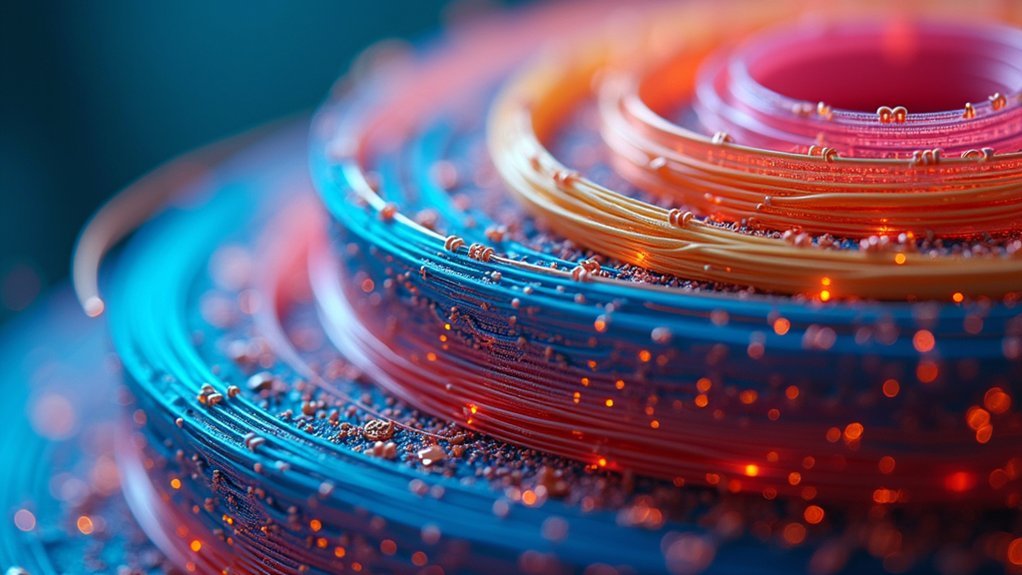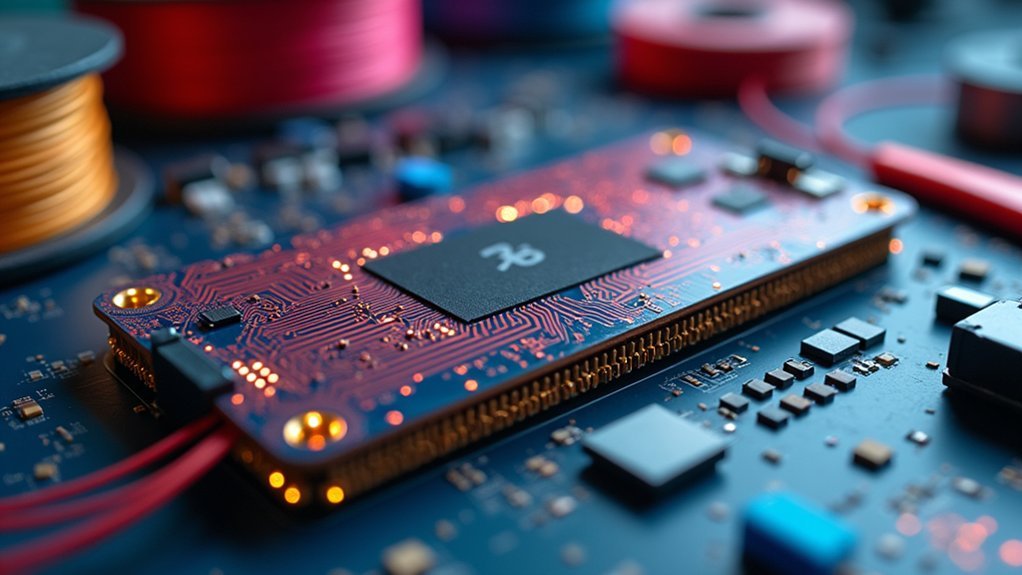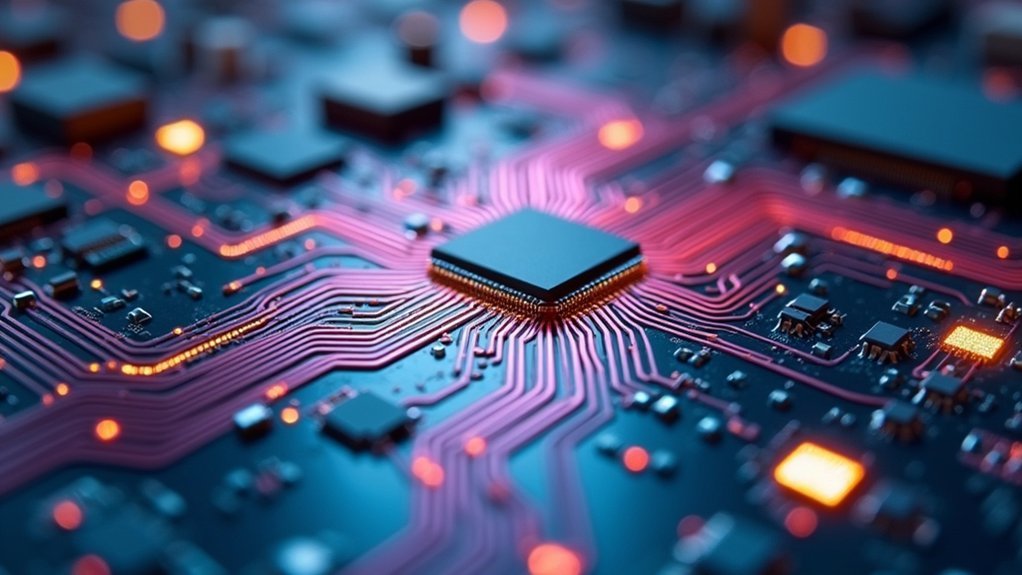You can revolutionize your electronic device creation by using conductive filament to embed circuits directly into 3D printed designs, eliminating separate wiring and reducing assembly time. This approach achieves complex geometries impossible with conventional manufacturing while handling low-voltage applications up to 60 volts safely. You’ll benefit from reduced production costs, improved durability, and seamless component integration during printing. The technology enables touch sensors, LED systems, and flexible electronics with electromagnetic interference shielding, opening possibilities you’ll discover ahead.
Benefits of Integrated Electrical Pathways in 3D Printed Objects

While traditional manufacturing methods constrain designers to separate electrical and structural components, integrated electrical pathways in 3D printed objects revolutionize how you can create electronic devices.
You’ll achieve complex geometries impossible with conventional techniques using conductive filament during additive manufacturing processes.
When you’re printing with conductive materials like conductive PLA, you can embed circuits directly into your designs. This multi-materials approach reduces assembly time while improving durability by eliminating separate components.
Your integrated electrical pathways effectively handle low voltage applications up to 60 volts, perfect for capacitive touch sensors and LED systems.
You’ll discover enhanced design flexibility when printing both conductive and non-conductive materials simultaneously.
This seamless integration creates more sophisticated electronic devices while providing electromagnetic interference shielding that boosts performance and reliability.
Material Properties and Conductivity Requirements for Electronics
When you’re selecting conductive filaments for electronics, you’ll need to balance electrical performance against mechanical limitations that don’t exist with traditional metals.
Your conductive PLA can handle up to 100 mA and 60 V safely, but it won’t match copper’s performance in high-current applications.
You’ll also face trade-offs where adding conductive fillers improves electrical properties but can compromise the material’s structural strength and printability.
Conductivity Vs Metal Performance
Although conductive filaments have revolutionized accessible electronics manufacturing, their electrical performance differs greatly from traditional metals in both capabilities and applications. When you’re designing electrical circuits, you’ll find conductive PLA offers resistivity values around 0.6 Ω-cm, making it suitable for low-power electronic applications up to 60V rather than high-current tasks.
| Property | Conductive PLA | Traditional Metals |
|---|---|---|
| Resistivity | 0.6 Ω-cm | 0.000017 Ω-cm (copper) |
| ESD Properties | Electrostatic Dissipative | Limited in plastic matrix |
| Z-axis Conductivity | Up to 115 Ω-cm | Uniform conductivity |
| Mechanical Properties | Brittleness concerns | Superior strength |
You’ll need to evaluate layer orientation carefully, as Z-axis conductivity noticeably decreases. While conductive PLA can’t match metals’ performance, it provides unique Electrostatic Dissipative properties for electromagnetic shielding applications.
Voltage and Current Limits
Understanding electrical limitations becomes critical for safe circuit design with conductive filaments. Your conductive filament operates within a voltage range of 0 to 60 V with a maximum safe current of 100 mA, making it ideal for low-power electronic applications.
Resistivity varies considerably from 0.6 Ω-cm to 115 Ω-cm depending on print orientation, directly affecting electrical conduction performance.
To guarantee reliable operation, you’ll need proper design considerations:
- Maintain wall thickness of at least 1 mm for adequate current transmission
- Use 100% infill density to create solid conductive pathways
- Consider orientation impact on resistivity when routing circuits
- Account for reduced structural integrity when using metal-additive filaments
These parameters ensure your printed electronics function safely within operational limits.
Mechanical Strength Trade-offs
Since conductive additives like carbon black and graphene enhance electrical properties, they simultaneously compromise the mechanical integrity of your printed components.
You’ll notice that conductive PLA exhibits increased brittleness compared to standard filament, as these additives raise the Young’s modulus while reducing toughness. This composite filament requires careful consideration when designing parts that need both electrical conductivity and structural integrity.
The trade-off becomes particularly evident in multi-materials fused filament printing applications where mechanical stress is a factor. While conductive PLA’s low melting point aids processing, you must balance electrical performance with durability requirements.
Implementing a minimum 1mm wall thickness helps maintain adequate mechanical strength, though you’ll still need to account for reduced flexibility in your designs when incorporating this material.
Design Flexibility and Structural Advantages of Multi-Material Approaches
You’ll discover that multi-material 3D printing unveils unprecedented design possibilities by enabling complex geometries that traditional manufacturing can’t achieve.
Your printed structures can integrate conductive pathways directly within dielectric materials, eliminating the need for separate assembly steps and creating seamless electronic components.
You can now design overhangs, internal channels, and intricate lattice structures that self-support during printing, removing constraints that once limited your electronic device architectures.
Complex Geometry Creation
Multi-material fused filament printing revolutionizes how you approach complex electronic designs by seamlessly integrating conductive and dielectric materials within a single manufacturing process.
You can now create intricate electrical components with complex geometries that traditional manufacturing simply can’t achieve. This printing technique lets you produce unsupported structures by carefully selecting materials and process parameters, enabling innovative designs with sophisticated features.
- Spiral antennas with embedded conductive pathways winding through transparent dielectric housings
- Flexible electronics that bend around curved surfaces while maintaining electrical connectivity
- Honeycomb sensor arrays with conductive traces threading through lattice structures
- Multi-layer circuit boards with internal conductive channels invisible from the exterior
Your design flexibility expands dramatically as you incorporate continuous fibers or metal wires, enhancing mechanical properties while maintaining compact, functional forms for diverse applications.
Support-Free Structure Benefits
Beyond these geometric innovations, support-free structures release unprecedented design freedom by eliminating the constraints and material waste associated with traditional support scaffolding.
You’ll achieve remarkable efficiency when integrating conductive materials directly into your designs, allowing seamless embedding of electronic components without additional assembly steps. By optimizing printing parameters, you can successfully create overhangs and intricate geometries essential for functional electronics.
Multi-material approaches deliver enhanced mechanical stability while maintaining superior electrical performance, making them ideal for flexible electronics applications.
You’ll find these capabilities particularly valuable in soft robotics, where suspended structures must withstand compressive forces while maintaining conductivity. This combination of structural integrity and electrical functionality opens new possibilities for capacitive sensors, health monitoring devices, and other advanced electronic systems requiring complex three-dimensional architectures.
Cost-Effective Manufacturing Through Embedded Circuit Fabrication

When manufacturers integrate conductive filaments into their 3D printing workflows, they’ll dramatically reduce both production costs and complexity by embedding electrical circuits directly into printed parts.
You’re eliminating separate assembly processes while creating complex geometries that weren’t possible with traditional manufacturing methods.
Multi-material fused filament printing lets you combine conductive PLA with standard materials, optimizing material usage for each component’s specific requirements.
You’ll achieve reliable electrical performance through 100% infill density printing, ensuring consistent current transmission at lower costs than conventional circuit fabrication.
- Touch sensors seamlessly integrated into smartphone cases during printing
- LED strips embedded within architectural lighting fixtures
- Custom circuit traces running through drone frames
- Smart home devices with built-in conductive pathways replacing external wiring
Applications in Sensors, Shielding, and Low-Voltage Devices
As conductive filament technology matures, you’ll find its most compelling applications emerge in three critical areas where traditional manufacturing falls short.
For sensors, conductive filament enables capacitive touch interfaces that detect proximity and responsiveness in your printed electronics. Low-voltage devices benefit greatly, as conductive PLA filament effectively transmits current up to 60V while maintaining structural integrity in 3D printed components.
| Application | Key Benefit | Voltage Range |
|---|---|---|
| Capacitive Sensors | Touch/proximity detection | 0-12V |
| EMI Shielding | RF interference protection | N/A |
| LED Circuits | Integrated wiring | 12-60V |
EMI shielding protects your devices from electromagnetic interference, while flexible electronics applications extend to health monitoring and soft robotics where conformability matters most.
Printing Techniques and Best Practices for Conductive Filaments

Successfully implementing these conductive filament applications requires mastering specific printing parameters that differ markedly from standard PLA workflows.
You’ll need to adjust your nozzle temperature to 240-255°C and reduce print speed to 20-25 mm/s for ideal material flow during multi-material printing. Set infill density to 100% guaranteeing effective current transmission and minimal electrical resistance.
Essential printing techniques include:
- Installing a hardened steel nozzle to withstand abrasive carbon-filled filament grinding against standard brass
- Increasing wall thickness to at least 1mm, creating robust pathways for electrical current flow
- Monitoring layer bonding carefully, as poor adhesion dramatically increases Z-axis resistance
- Cleaning nozzle with alcohol between prints, preventing solidified conductive material from blocking future extrusion
These adjustments guarantee structural integrity while maintaining conductivity throughout your printed electronics.
Performance Considerations and Limitations in Electronic Applications
Although conductive PLA offers exciting possibilities for 3D printed electronics, you’ll encounter specific performance boundaries that directly impact your project’s feasibility. This electrically conductive filament provides high electrical conductivity for low-voltage applications up to 60V, but you’re limited to 100mA current transfer. The material’s 0.6 Ω-cm resistivity makes it suitable for strain sensors and LED circuits at low cost.
However, you’ll face significant limitations when using printed objects by fused material extrusion. The low conductivity along the Z-axis (115 Ω-cm) reduces effectiveness in layered structures.
The conductivity of the composite also creates brittleness, requiring thicker walls and 100% infill. These constraints mean you can’t use conductive PLA for high-current applications or structurally demanding components.
Frequently Asked Questions
What Is a Conductive Filament Used For?
You’ll use conductive filament to create integrated electronic circuits within 3D printed parts, build EMI shielding enclosures, manage static electricity, and simultaneously print wiring with structural components for streamlined manufacturing.
What Is a Conductive Substance Used in 3D Printers to Produce Electronic Parts?
You’ll use conductive filament containing carbon black or metal particles in your 3D printer. It’s specifically designed to transmit electrical current, letting you create functional electronic parts and circuits directly.
What Is the Best Filament for Electronics?
You’ll want conductive PLA for most electronics projects since it’s reliable up to 60V with 0.6 Ω-cm resistivity. Choose conductive ABS if you need toughness, or TPU for flexible applications.
Is an ESD Filament Conductive?
ESD filaments are conductive, but they’re designed for static dissipation rather than power transmission. You’ll find their resistivity ranges from 10^6 to 10^9 Ω, making them less conductive than standard conductive filaments.





Leave a Reply